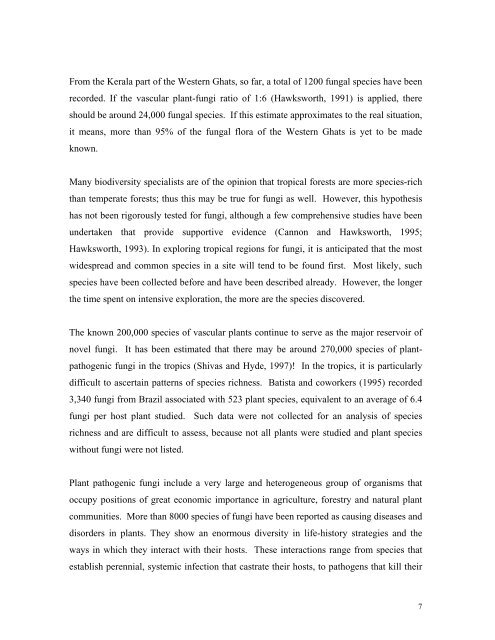Biodiversity of Plant Pathogenic Fungi - Kerala Forest Research ...
Biodiversity of Plant Pathogenic Fungi - Kerala Forest Research ...
Biodiversity of Plant Pathogenic Fungi - Kerala Forest Research ...
Create successful ePaper yourself
Turn your PDF publications into a flip-book with our unique Google optimized e-Paper software.
From the <strong>Kerala</strong> part <strong>of</strong> the Western Ghats, so far, a total <strong>of</strong> 1200 fungal species have been<br />
recorded. If the vascular plant-fungi ratio <strong>of</strong> 1:6 (Hawksworth, 1991) is applied, there<br />
should be around 24,000 fungal species. If this estimate approximates to the real situation,<br />
it means, more than 95% <strong>of</strong> the fungal flora <strong>of</strong> the Western Ghats is yet to be made<br />
known.<br />
Many biodiversity specialists are <strong>of</strong> the opinion that tropical forests are more species-rich<br />
than temperate forests; thus this may be true for fungi as well. However, this hypothesis<br />
has not been rigorously tested for fungi, although a few comprehensive studies have been<br />
undertaken that provide supportive evidence (Cannon and Hawksworth, 1995;<br />
Hawksworth, 1993). In exploring tropical regions for fungi, it is anticipated that the most<br />
widespread and common species in a site will tend to be found first. Most likely, such<br />
species have been collected before and have been described already. However, the longer<br />
the time spent on intensive exploration, the more are the species discovered.<br />
The known 200,000 species <strong>of</strong> vascular plants continue to serve as the major reservoir <strong>of</strong><br />
novel fungi. It has been estimated that there may be around 270,000 species <strong>of</strong> plantpathogenic<br />
fungi in the tropics (Shivas and Hyde, 1997)! In the tropics, it is particularly<br />
difficult to ascertain patterns <strong>of</strong> species richness. Batista and coworkers (1995) recorded<br />
3,340 fungi from Brazil associated with 523 plant species, equivalent to an average <strong>of</strong> 6.4<br />
fungi per host plant studied. Such data were not collected for an analysis <strong>of</strong> species<br />
richness and are difficult to assess, because not all plants were studied and plant species<br />
without fungi were not listed.<br />
<strong>Plant</strong> pathogenic fungi include a very large and heterogeneous group <strong>of</strong> organisms that<br />
occupy positions <strong>of</strong> great economic importance in agriculture, forestry and natural plant<br />
communities. More than 8000 species <strong>of</strong> fungi have been reported as causing diseases and<br />
disorders in plants. They show an enormous diversity in life-history strategies and the<br />
ways in which they interact with their hosts. These interactions range from species that<br />
establish perennial, systemic infection that castrate their hosts, to pathogens that kill their<br />
7

















